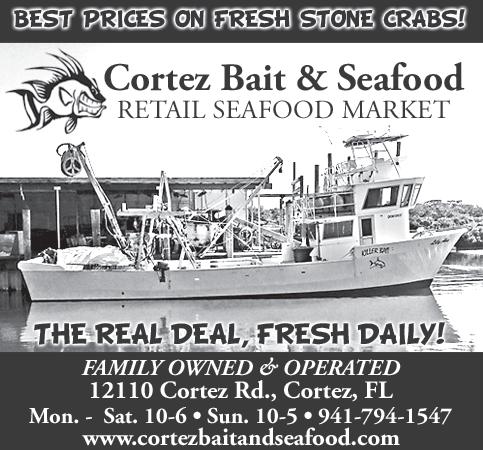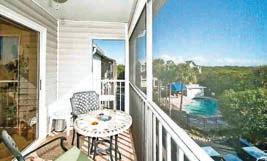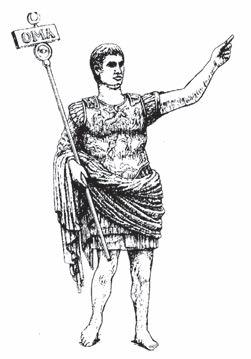
6 minute read
REEL TIME
THE SUN OUTDOORS DECEMBER 16, 2020
Threatened seagrass has trickle-down effect
Reel Time





RUSTY CHINNIS
The seagrass beds that carpet Sarasota Bay harbor a tremendous array of living creatures. This critical and diverse ecosystem is generally out of sight except at extreme low tides.
Seagrasses are actually underwater flowering plants that serve a number of important functions. They produce oxygen, bind sediments and baffle wave action while cleansing the water column. Seagrass roots, their leaves, and the epiphytes and microalgae that cling to them clean water by converting dissolved nutrients into plant matter. Besides giving us clean and clear water, seagrasses are home to the organisms that provide food and shelter for fish, crustaceans, shellfish and wading birds. They also are food sources for manatees, sea turtles and various fish and crustaceans. Because they flower, seagrasses require sunlight and are limited to clear, shallow waters.
Of the 52 species of seagrasses worldwide, only seven are found in Florida. Three main species are found on Florida’s southwest coast. They include turtle grass (Thalassia testudinum), shoal grass (Halodule wrightii) and manatee grass (Syringodium filiforme). The historical loss of these species has been extensive throughout Florida. Tampa Bay has lost 81% of its historical seagrasses, Sarasota Bay 35% and Charlotte Harbor 29%. Poor watershed management (stormwater runoff and sewage disposal) dredge and fill operations and scarring from boat propellers have taken a heavy toll on Florida’s seagrasses.
Through the elimination of small, poorlymaintained regional sewage systems and the work of organizations like the Sarasota Bay Estuary Program, Tampa Bay Estuary Program, and Tampa Bay Watch, programs were instituted that began to turn the tide







SUBMITTED Harmful algae blooms like this occurrence of lyngbya on the east side of Anna Maria Sound are indicative of poor water quality and smother seagrasses.

on water quality.
Anglers, from experience, are aware of the importance of these prolific, shallow beds. They experience firsthand the myriad interactions that produce fertile fisheries. They may not understand the intricate web of existence that proceeds from the microscopic level to the fish on the end of

SEE REEL TIME, PAGE 23




Fishing stellar under new moon
CAPTAIN DAVE WHITE
Boy oh boy. The weekend sure was a beautiful one! Conditions were amazing for both inshore and offshore fishing. That, coupled with a new moon, made things absolutely stellar on the water.
We here at Anna Maria Charters come prepared with shrimp, pinfish and pilchards this time of year. The sheepshead, black drum and pompano are starting to move in and ready to eat shrimp. Yet the snook, redfish, trout and jack crevalle are still feeding on pilchards. The gag grouper bite has been great inshore as well.
For our offshore trips, we focused on hogfish and gag grouper as well. The bigger hogs seem to slide in when it gets a little bit chilly out there. So we’ll take it! These are definitely one of the best tasting fish on the planet.
Looks like we’re back to some windy conditions and a quick cold front mid-week. Hopefully, it gets back to flat sooner than later!
CAPTAIN RICK GRASSETT
Anglers fishing with me out of CB’s Saltwater Outfitters on Siesta Key had good action with trout in Sarasota Bay and tripletail in the coastal Gulf on flies and DOA Lures recently.
Greg Stepanski, of Tampa, fished the coastal Gulf with me and caught and released his first tripletail on a fly. Great job! Steve Gibson, of Southern Drawl Kayak Fishing, also fished the coastal Gulf with me and had good action with tripletail, landing two out of three on flies.
My brother, Joe Grassett, of Seaford, Delaware, visited and fished Sarasota Bay a few days with me recently. His visit coincided with a cold front, which provided some classic winter trout fishing. With water temperatures plummeting, we fished CAL jigs with jerk worms, low and slow, and caught and released


REEL TIME: Threatened seagrass has trickle-down effect FROM PAGE 22 reveals that the effectiveness of mitigat- protecting the quality of our most valutheir line, but they reap the benefits, none- ing seagrass damage is considered, even able local resources. Enlightened citizens, theless. Government scientists (NOAA) among the leading wetland scientists, as anglers and their interest groups must take consider seagrasses to be of such impor- marginal at best. part in this decision-making process. tance that they have adopted a “no net In recent years, seagrass rebounded in Cost considerations often eclipse conloss” policy to manage them. Despite this Sarasota Bay. Unfortunately, that trend cerns for seagrasses, but research reveals pronouncement, seagrasses remain under reversed after the red tide of 2018, and now the true value of these resources. A study assault. there have been reports by local fishing (Virnstein and Morris 1996) conducted
Preventing the loss of valuable seagrasses guides including Captain Justin Moore in the Indian River Lagoon estimated the must be a high priority. Watershed man- and Captain Todd Romine that acres of value of seagrass to be $12,500 per acre, agement, replanting, avoidance of direct once-lush seagrasses have been reduced to per year, based solely on economic values impacts to existing grasses, and mitigation sand flats. It is a foregone conclusion that derived from recreational and commercial are avenues to reach those goals. Mitiga- development will continue to impact coastal fisheries. In the last few years, the effects tion involves the replacement of seagrasses areas and their seagrass resources. It is vital of rampant development, antiquated and impacted by residential and commercial that decisions are made that will accom- failing infrastructure, and associated stormdevelopment. Unfortunately, the literature modate unavoidable development while water runoff are feeding red tide events numerous quality trout.
Fish the coastal Gulf for tripletail when conditions are good. Fishing deep grass flats of Sarasota Bay is a good choice for action with a variety of species, including trout, blues and Spanish mackerel. Shallow water action for reds and snook should also be a good option now.
Our natural resources are under constant pressure from red tides fueled by industrial, agricultural and residential runoff, freezes, increasing fishing pressure and habitat loss and degradation. Please limit your kill, don’t kill your limit!


and algae blooms, and threatening the very existence of the bay's seagrass system.
Groups like Suncoast Waterkeeper and Tampa Bay Waterkeeper, with the Sarasota Bay Estuary Program, alarmed at the prospect of a potential collapse of the bay (like the one that has plagued the Indian River Lagoon) have sprung into action to alert the public through education, effective policy and in the case of the Waterkeeper Groups, hold governments accountable under the rules of the Clean Water Act of 1972. It is imperative that citizens let leaders know they will hold them responsible to protect the resources that form the basis of our quality of life as well as the local economy.




